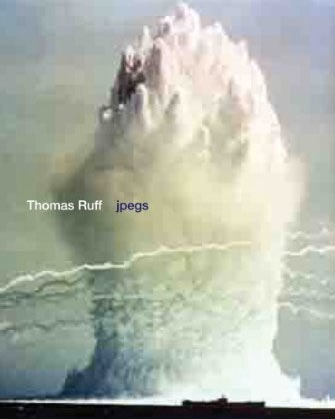Review: jpegs by Thomas Ruff

Thomas Ruff might be one of the most creative and certainly inventive photographers of our time. In fact, many people - especially adherents of photographic orthodoxy - will probably vehemently deny that most of Ruff’s recent work is actually photography. In general debates about whether something is photography or not, and if it’s not photography then what else, are not terribly exciting, and there is no need to get into them here. What is more interesting is to look at that work and to see what it does (call it photography, graphic design, visual art, whatever).
At the time of this writing, Ruff’s jpegs are his most recent body of work. In an interview, the artist explained its history as follows1: “Everything began with 9/11, the attack on the World Trade Center. That week […] I was in New York […]. I took many photos. When I got the negatives back from the lab in Germany, they were all blank. […] I finally downloaded a lot of images from the web. […] That was when I began to experiment with the ‘jpeg’ images […] The 9/11 images were iconic, but of terribly low resolution. With the […] jpeg structure and the results from work with image structures I managed to modify the terribly poorly resolved but still visually aesthetical images my way. ‘Terribly beautiful’ images they were.” In a nutshell, this is the idea behind jpegs. Ruff eventually expanded his jpegs into a rather large set, the subject of two large shows at Zwirner gallery, and the subject of Jpegs.
I had been looking forward to the publication of Jpegs ever since I first heard about it, since I had a hunch. As it turns out my hunch was correct: Ruff’s jpegs work amazingly well in book form. It is a rather large book, beautifully printed. For me, seeing the jpegs in the book actually works much better than seeing them as gigantic prints in the Zwirner gallery setting where, well, there was that whiff of things being just a tad too pretentious. Of course, I understand the basic idea of having large prints - they require physical involvement of the viewer. But even without knowing what the images would look like in a book I thought that the amount of detail in the images was actually not large enough to justify the sizes shown in the gallery (of course, the business behind that gallery dictated otherwise). As a book, everything just works beautifully. I give Aperture a lot of credit for producing this book.
But then there is this unease that I’ve had with this work, which I expressed several times on this blog (find the most recent example here). The tremendous beauty of some of the images notwithstanding, the concept itself seems to rely a bit too much on the technique itself. What else is there? Make no mistake, there is nothing wrong with producing beautiful images or images that are “just” beautiful. And everything would be fine if there hadn’t been so many attempts to convince me that in reality “jpegs” is more. What that “more” really is I never managed to find out. Unfortunately, the text in Jpegs did not help me much, either. At various stages, I thought “Well, now we’re getting somewhere”, only for the author to end a thought. Well, sure, images on the web often have low resolution, and if you blow them up then they show funny patterns (caused by the image compression algorithms2), and of course, photography’s role has been changing through its use online - but all that is just so obvious! I get it!
Of course, I’m being overly critical - probably in part because of Ruff’s willingness to push the boundaries of photography. I give him tremendous credit for that, to see what photography is, what it can do, where it might go… But now’s the time to move beyond form.
Or maybe sometimes, the medium is the message (and I’m expecting too much).
Either way, Jpegs is a stunningly beautiful book. Seeing the images in the book has made me re-appreciate the sheer beauty of this body of work, despite the ultimate thinness of the concept behind it.
1 Excerpt from a conversation with Max Dax, original in German (my translation), from Max Dax, Dreissig Gespräche, edition suhrkamp, 2009
2 Disclaimer: My scientific past contains a longish stint in a group working on digital image processing.